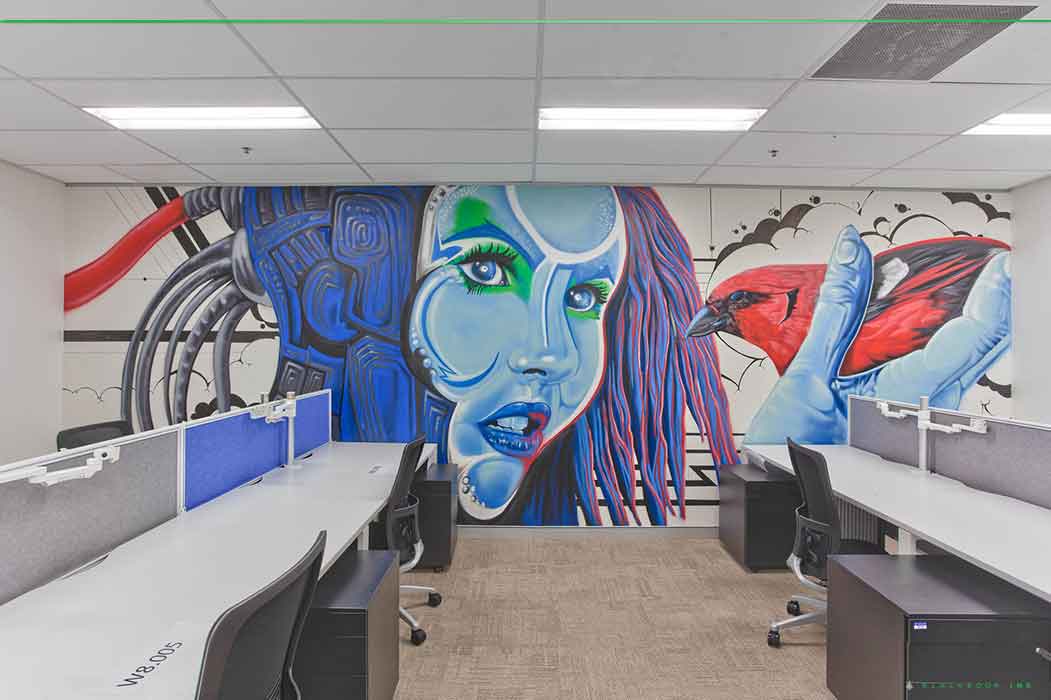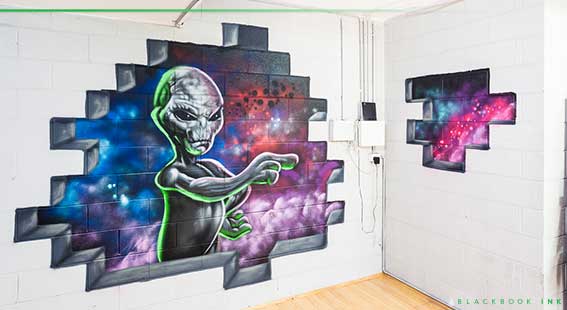|
|
Visit SYDNEY 🇭🇲 Australia Street Art, Galleries, Events, by andyroo0312 on Oct 18, 2014 10:34:22 GMT 1, Cool,,, thanks for the info and link. I always wonder why Sydney does not have a vibrant street art scene compared to,,,, well any where else in the world except Singapore, there are so many blank spaces just crying out for some talent with a can,brush,roller or wheat paste to transform,, rant over thanks again.. 
Cool,,, thanks for the info and link. I always wonder why Sydney does not have a vibrant street art scene compared to,,,, well any where else in the world except Singapore, there are so many blank spaces just crying out for some talent with a can,brush,roller or wheat paste to transform,, rant over thanks again..  |
|
Stoko
Artist
Junior Member

🗨️ 1,706
👍🏻 1,108
June 2010
|
Visit SYDNEY 🇭🇲 Australia Street Art, Galleries, Events, by Stoko on Oct 18, 2014 12:54:46 GMT 1, Good call, many thanks
Good call, many thanks
|
|
astrobboy
New Member

🗨️ 399
👍🏻 239
September 2008
|
Visit SYDNEY 🇭🇲 Australia Street Art, Galleries, Events, by astrobboy on May 7, 2015 22:45:05 GMT 1, www.smh.com.au/technology/technology-news/mousetrap-sydney-trains-sniff-out-graffiti-vandals-with-new-technology-20150507-ggw34g.html
Sydney's trains are being fitted with sniffing technology to catch graffiti vandals in the act.
More than 30 offenders have already been caught under the scheme, which the state government is calling "mousetrap".
"This is innovative technology," said Transport Minister Andrew Constance.
"Mousetrap is on-board technology designed to scent the vapours of permanent markers, providing real-time information with the triggering of CCTV back to Sydney Trains staff and then, of course, also real-time information being provided to the Police Transport Command," Mr Constance said.
"Those who commit graffiti across the network can now be sprung immediately. With can in hand, marker in hand, doing the damage - you will get caught."
Sydney Trains chief executive Howard Collins said the system cost about $500,000. The state spent about $34 million removing graffiti last year.
However, Mr Collins remained tight-lipped about many of the details of the program, including how many trains were fitted with the sensors and where they were fitted.
"This is covert, you can't see them, there are many of them," he said.
"It's moveable, and therefore as far as we are concerned it is a technology that can be used in many locations."
The sensors do register other smells, and it can be difficult to differentiate between the vapour of graffiti or, say, someone transporting house paint. The sensors alert Sydney Trains or police staff monitoring CCTV footage, who are then able to see what has triggered the alert.
There were about 11,000 incidents of graffiti and vandalism on the city's rail system last year, and the problem is regularly cited in surveys as one of the major bugbears of Sydney commuters.
The sensors respond to the vapours released by spray cans and permanent markers. Once the sensors are triggered, they activate an alarm received either on mobile equipment held by police or by Sydney Trains staff.
A trial of the program started in the middle of last year, Mr Collins said, and would be extended to more locations.
www.smh.com.au/technology/technology-news/mousetrap-sydney-trains-sniff-out-graffiti-vandals-with-new-technology-20150507-ggw34g.htmlSydney's trains are being fitted with sniffing technology to catch graffiti vandals in the act. More than 30 offenders have already been caught under the scheme, which the state government is calling "mousetrap". "This is innovative technology," said Transport Minister Andrew Constance. "Mousetrap is on-board technology designed to scent the vapours of permanent markers, providing real-time information with the triggering of CCTV back to Sydney Trains staff and then, of course, also real-time information being provided to the Police Transport Command," Mr Constance said. "Those who commit graffiti across the network can now be sprung immediately. With can in hand, marker in hand, doing the damage - you will get caught." Sydney Trains chief executive Howard Collins said the system cost about $500,000. The state spent about $34 million removing graffiti last year. However, Mr Collins remained tight-lipped about many of the details of the program, including how many trains were fitted with the sensors and where they were fitted. "This is covert, you can't see them, there are many of them," he said. "It's moveable, and therefore as far as we are concerned it is a technology that can be used in many locations." The sensors do register other smells, and it can be difficult to differentiate between the vapour of graffiti or, say, someone transporting house paint. The sensors alert Sydney Trains or police staff monitoring CCTV footage, who are then able to see what has triggered the alert. There were about 11,000 incidents of graffiti and vandalism on the city's rail system last year, and the problem is regularly cited in surveys as one of the major bugbears of Sydney commuters. The sensors respond to the vapours released by spray cans and permanent markers. Once the sensors are triggered, they activate an alarm received either on mobile equipment held by police or by Sydney Trains staff. A trial of the program started in the middle of last year, Mr Collins said, and would be extended to more locations.
|
|
|
|
Visit SYDNEY 🇭🇲 Australia Street Art, Galleries, Events, by searchandrescue on May 8, 2015 10:22:51 GMT 1, www.smh.com.au/technology/technology-news/mousetrap-sydney-trains-sniff-out-graffiti-vandals-with-new-technology-20150507-ggw34g.htmlSydney's trains are being fitted with sniffing technology to catch graffiti vandals in the act. More than 30 offenders have already been caught under the scheme, which the state government is calling "mousetrap". "This is innovative technology," said Transport Minister Andrew Constance. "Mousetrap is on-board technology designed to scent the vapours of permanent markers, providing real-time information with the triggering of CCTV back to Sydney Trains staff and then, of course, also real-time information being provided to the Police Transport Command," Mr Constance said. "Those who commit graffiti across the network can now be sprung immediately. With can in hand, marker in hand, doing the damage - you will get caught." Sydney Trains chief executive Howard Collins said the system cost about $500,000. The state spent about $34 million removing graffiti last year. However, Mr Collins remained tight-lipped about many of the details of the program, including how many trains were fitted with the sensors and where they were fitted. "This is covert, you can't see them, there are many of them," he said. "It's moveable, and therefore as far as we are concerned it is a technology that can be used in many locations." The sensors do register other smells, and it can be difficult to differentiate between the vapour of graffiti or, say, someone transporting house paint. The sensors alert Sydney Trains or police staff monitoring CCTV footage, who are then able to see what has triggered the alert. There were about 11,000 incidents of graffiti and vandalism on the city's rail system last year, and the problem is regularly cited in surveys as one of the major bugbears of Sydney commuters. The sensors respond to the vapours released by spray cans and permanent markers. Once the sensors are triggered, they activate an alarm received either on mobile equipment held by police or by Sydney Trains staff. A trial of the program started in the middle of last year, Mr Collins said, and would be extended to more locations.
www.smh.com.au/technology/technology-news/mousetrap-sydney-trains-sniff-out-graffiti-vandals-with-new-technology-20150507-ggw34g.htmlSydney's trains are being fitted with sniffing technology to catch graffiti vandals in the act. More than 30 offenders have already been caught under the scheme, which the state government is calling "mousetrap". "This is innovative technology," said Transport Minister Andrew Constance. "Mousetrap is on-board technology designed to scent the vapours of permanent markers, providing real-time information with the triggering of CCTV back to Sydney Trains staff and then, of course, also real-time information being provided to the Police Transport Command," Mr Constance said. "Those who commit graffiti across the network can now be sprung immediately. With can in hand, marker in hand, doing the damage - you will get caught." Sydney Trains chief executive Howard Collins said the system cost about $500,000. The state spent about $34 million removing graffiti last year. However, Mr Collins remained tight-lipped about many of the details of the program, including how many trains were fitted with the sensors and where they were fitted. "This is covert, you can't see them, there are many of them," he said. "It's moveable, and therefore as far as we are concerned it is a technology that can be used in many locations." The sensors do register other smells, and it can be difficult to differentiate between the vapour of graffiti or, say, someone transporting house paint. The sensors alert Sydney Trains or police staff monitoring CCTV footage, who are then able to see what has triggered the alert. There were about 11,000 incidents of graffiti and vandalism on the city's rail system last year, and the problem is regularly cited in surveys as one of the major bugbears of Sydney commuters. The sensors respond to the vapours released by spray cans and permanent markers. Once the sensors are triggered, they activate an alarm received either on mobile equipment held by police or by Sydney Trains staff. A trial of the program started in the middle of last year, Mr Collins said, and would be extended to more locations. |
|
|
|
Visit SYDNEY 🇭🇲 Australia Street Art, Galleries, Events, by blackbookink on Aug 6, 2020 11:45:14 GMT 1, Street Art painted by Blackbook Ink in Sydney

|
|
|
|
Visit SYDNEY 🇭🇲 Australia Street Art, Galleries, Events, by blackbookink on Aug 6, 2020 11:47:00 GMT 1, 
|
|
|
|
|
|































